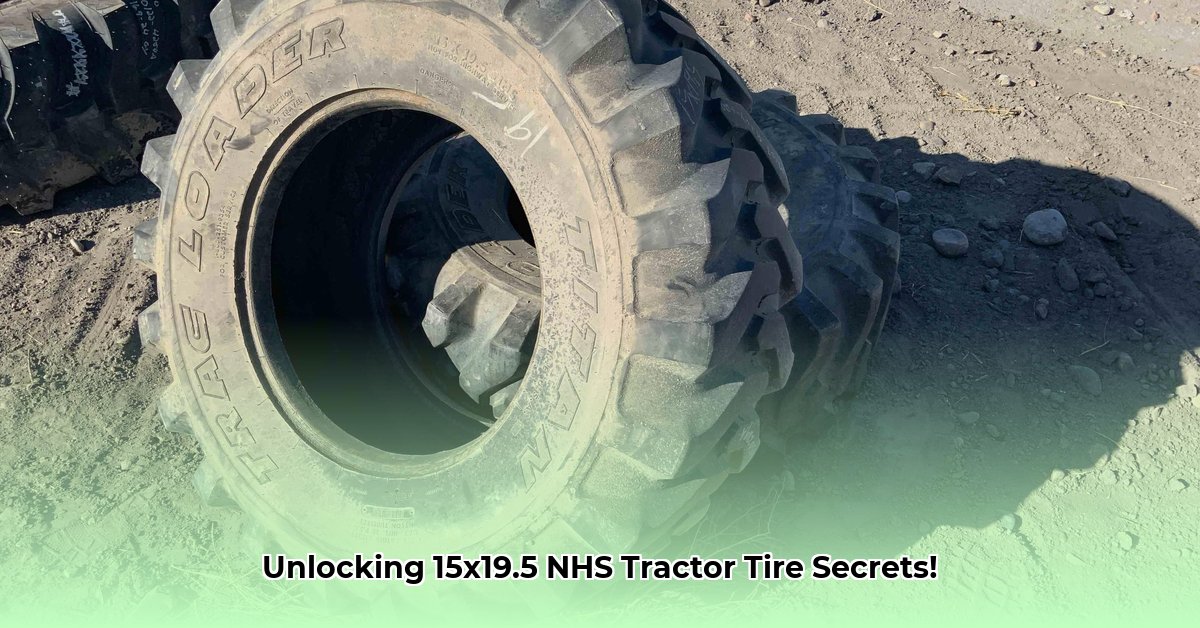
Choosing the right tires for your heavy machinery is crucial for optimal performance and longevity. This article focuses on the 15x19.5 NHS Titan Trac Loader SS tire, a popular choice for skid steers and loaders. We'll explore its specifications, performance characteristics, and maintenance requirements to help you make an informed decision. For more information on Firestone tires, check out Firestone Tractor Tires.
Decoding the 15x19.5 NHS Tire Size
The designation "15x19.5 NHS" provides essential information about the tire. "15" represents the rim diameter in inches (the size of the wheel), while "19.5" indicates the overall tire diameter in inches. "NHS" stands for Non-Highway Service, signifying its suitability for off-road applications and potentially restricted legal use on paved roads. The missing section width (the tire's width from sidewall to sidewall) is typically available in manufacturer specifications. Isn't it amazing how much information is encoded in this seemingly simple label?
Load Capacity and Ply Rating: Handling Heavy Loads
A tire's load capacity is critical. The 15x19.5 NHS Titan Trac's load capacity varies depending on factors like inflation pressure and tire construction. This crucial information is printed on the tire's sidewall and should always be checked before use. Higher ply ratings typically indicate greater load-bearing capacity and puncture resistance. Consider your typical hauling tasks: Are you moving heavy machinery or lighter materials? The right tire can make all the difference.
Tread Patterns: Traction and Terrain
The tread pattern significantly impacts traction. The "Titan Trac Loader SS" tread, common on 15x19.5 NHS tires, is designed for reliable grip in various off-road conditions. However, different tread patterns excel in different environments. For instance, some are better suited for muddy conditions, while others perform better on hard-packed soil. What is the predominant terrain on your worksite? Matching tire tread pattern and terrain is crucial for maintaining traction and tire lifespan.
Choosing the Right Tire: Matching Your Needs
Selecting a tire isn't just about the numbers; it involves considering your specific needs and working conditions. What are your primary applications? Heavy hauling requires a high load-bearing capacity, while frequent road use needs durability and road-going performance. By carefully evaluating your operational demands, you maximize your investment. Is it worth investing in a specialized tire to suit individual operating needs?
Maintaining Your Tires: Extending Lifespan
Proper tire maintenance is paramount for extending its operational life and maximizing ROI. Maintaining the correct inflation pressure is critical, as underinflation leads to increased wear and reduced fuel efficiency, whereas overinflation can cause premature failure. Regular inspections for cuts, embedded objects, or uneven wear are also essential. Early detection of issues prevents costly repairs down the line. How would you rate the importance of preventative maintenance in prolonging the lifespan of your tires?
Maximizing Skid Steer Tire Lifespan with 15x19.5 NHS Titan Trac
Let's explore strategies for maximizing the lifespan of your 15x19.5 NHS Titan Trac tires on skid steers. These workhorses can last a long time with proper care.
Tire Pressure: The Unsung Hero
Maintaining correct tire pressure is essential. Underinflation leads to excessive wear and tear, while overinflation can cause premature failure. Regular pressure checks are vital—consult the tire's sidewall for the recommended pressure. Why is consistent tire pressure monitoring crucial for extending tire life?
Driving Style and Terrain Considerations
Aggressive driving accelerates wear, while smooth operation significantly prolongs tire life. Similarly, different terrains demand different approaches. Operating on hard surfaces causes more wear than softer ground. How does your driving style and terrain impact your tire's lifespan?
Regular Inspections: Catching Problems Early
Regular inspections for cuts, bulges, or excessive wear are key to early detection and prevent further damage. Cleanliness is crucial for identifying underlying issues. Why are regular inspections so crucial for maintaining your tire's health?
Rotation and Maintenance
Rotating your tires ensures even wear distribution and extends their lifespan. Keeping your tires clean allows for quicker identification of any potential issues.
Key Takeaways: Three Pivotal Points for Tire Longevity
- Consistent tire pressure maintenance is crucial. Avoid both underinflation and overinflation.
- Smooth driving style and terrain awareness extend tire life and performance. Consider how these factors influence wear and tear.
- Regular inspections, rotation, and cleaning are vital for early problem detection and preventative maintenance. A small investment in time can significantly impact overall lifespan.